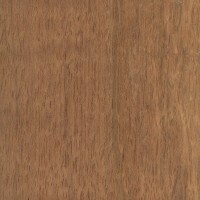 |
Common Name(s): Jatoba, Brazilian Cherry Scientific Name: Hymenaea courbaril Distribution: Central America, southern Mexico, northern South America, and the West Indies Tree Size: 100-130 ft (30-40 m) tall, 2-4 ft (.6-1.2 m) trunk diameter Average Dried Weight: 57 lbs/ft3 (910 kg/m3) Specific Gravity (Basic, 12% MC): .77, .91 Janka Hardness: 2,690 lbf (11,950 N) Modulus of Rupture: 22,510 lbf/in2 (155.2 MPa) Elastic Modulus: 2,745,000 lbf/in2 (18.93 GPa) Crushing Strength: 11,780 lbf/in2 (81.2 MPa) Shrinkage: Radial: 4.2%, Tangential: 8.0%, Volumetric: 12.1%, T/R Ratio: 1.9 |
Color/Appearance: Heartwood varies from a light orangish brown to a darker reddish brown, sometimes with contrasting darker grayish brown streaks. Color tends darken upon exposure to light. Sapwood is a light grayish yellow, clearly demarcated from the heartwood.
Grain/Texture: Grain is typically interlocked, with a medium to coarse texture. Good natural luster.
Endgrain: Diffuse-porous; large pores, very few; solitary and radial multiples of 2-3; mineral deposits (dark brown) occasionally present; parenchyma vasicentric, aliform (lozenge or winged), confluent, and marginal; narrow to medium rays, normal spacing.
Rot Resistance: Jatoba is rated as being very durable in regards to rot resistance, and is also resistant to termites and most other insects. (Though it has been reported to be susceptible to attack from marine borers.)
Workability: Jatoba is considered difficult to work with on account of its density and hardness, and has a moderate blunting effect on tool cutters. Jatoba also tends to be difficult to plane without tearout due to its interlocking grain. However, Jatoba glues, stains, turns, and finishes well. Responds well to steam-bending.
Odor: No characteristic odor.
Allergies/Toxicity: Although severe reactions are quite uncommon, Jatoba has been reported to cause skin irritation. See the articles Wood Allergies and Toxicity and Wood Dust Safety for more information.
Pricing/Availability: Available in satisfactory sizes and widths as lumber, and also available as flooring planks. Jatoba is inexpensive for an imported timber.
Sustainability: This wood species is not listed in the CITES Appendices, and is reported by the IUCN as being a species of least concern.
Common Uses: Flooring, furniture, cabinetry, tool handles, shipbuilding, railroad ties, turned objects, and other small specialty items.
Comments: Although it’s widely named “Brazilian Cherry,” (mostly among flooring sellers), it bears little relation to the domestic Cherry (Prunus serotina) that is found in the US, except perhaps that its natural color closely matches the common stained color of domestic Cherry that has been aged/stained reddish-brown as seen on some interior furniture.
Jatoba is exceptionally stiff, strong, and hard—representing a great value for woodworkers seeking high-strength, low-cost lumber.
None available.


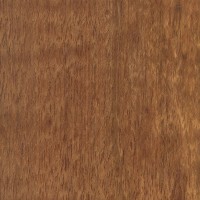
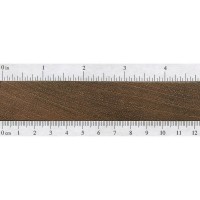
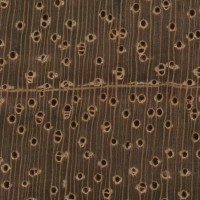
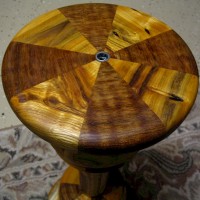



In regard to using any wood furniture outdoors on the Oregon coast I would strongly recommend only do so for the months of July , August and September. Then bring it inside , inspect it, and find a use for it undercover for for the rest if the year. Then learn to appreciate the form and don’t even try to keep it from going the beautiful gray color that UV light will cause. All things will fade, some are just a little slower than others..(Words of wisdom from an 80 year old builder on the coast for 50 years.)
I use a fair bit of Jatoba. I’ve come across curly Jatoba but only recently I found two boards in an old pile of mine that are “Birds Eye” Jatoba. Does this have another name or is this a fluke and it’s not a recognized pattern within the species? Can anyone help?
Jatoba has been used for guitar fingerboards lately. Probably as rosewood gets more expensive?
I believe that you will find that the use of Indian Laurel is more commonly being used as an alternative to Indian Rosewood. It’s not quite as dark as rosewood, but is a decent fretboard wood. Jatoba is much less expensive and very light in colour so while some Asian builds use Jatoba, it is typically stained to achieve the desired look and because it costs substantially less than either rosewood or laurel.
Hello Erik i want ask for little help in identifi wood. I was recive nice heavy wood from godfather off mine childern. His father was have that wood hiden in working place for ower 40 years. I try calculate how heavy that wood is and result is arround 1300kg / m2. I try sandding and do endgrain macro. Look like it is Jatoba but weight doesnt match and i see little diference in engrain photo. Regards from Prague {central Europe} Tomas
Do you have any photos of the wood? Also, what humidity level was the wood stored at when you weighed it?
Hello Erik, i do not have humidity meter but the wood was ower 40 years hidden in total dry workshop.
For sure i have photos.
Also i long time thinking to send you some lilac photos for your nice wood database.
I love lilac wood and lilac grow here behind mine window in Prague. I use lilac for knife handles. Doo you want ?
I agree that it very much looks like jatoba. The weight does seem abnormally high however, so I’m not sure what to make of that. Can you confirm that any offcuts, etc. do indeed sink in water?
(Also, I should be set on lilac samples, though I’d be interested in getting any photos of objects that you might have made with lilac.)
I have a sample described very similar to above photos by Tomas that I finally got around to trying to identify after about a year having left it in the garage. At first I thought it was some sort of rosewood but it’s too heavy, too straight grained, and there’s no distinctive scent of consequence. My density calculation comes in at 71 lbs/cf where indoor humidity near Portland, OR averages around 47% +/- 10% depending on the season. It sinks in water. Initially it’s weight and feel reminded me of desert ironwood since I have some experience with that, so… Read more »
I was given a large coffee table from a family who used to live in São Paulo, Brazil. They don’t know what kind of wood it is. I’m wondering if it’s Jatobá, but not sure. I’ve attached a picture of the top of the table and my best attempt at showing the endgrain. Any idea if I’m on the right track?
If that is finished wood with a topcoat applied, I’d say at the very least the color looks too light to be jatoba. But I’d need to see a finely sanded shot of the endgrain to be able to tell more.
I am just finishing up a jatoba garden bench, from the Japanese Garden Bench plan from Russell Jensen. It was a challenging project, to be sure. The thicker pieces are epoxy-laminated from 3 layers, and smaller structural pieces from 2 layers. It has 40 mortise and tenon joints. I added the tranquility carving to the back center rail, using a router and template I made on the bandsaw. I was surprised when I got to what I thought would be the easiest part of the project – screwing down the seat slats. I thought that would be easy. Even after… Read more »
Can you try attaching the picture again? It didn’t come through.
Teak weathers pretty well on it’s own, but it does turn a silvery color, so if color is important, you might want to give it more protection.
Trying again to attach the picture. You mention how teak weathers, so you know how jatoba weathers?
Sorry, I got mixed up when you started mentioning teak at the end of your comment. If it were me, I would apply a finish to jatoba. Given the amount of rainfall and wet-dry cycles you’ll probably encounter, I’d use a finish more for dimensional stability in the wood with changes in humidity than for rot resistance. Also be sure to give a liberal coating to the bottoms of the legs/feet and all endgrain surfaces.
Nicely done.
That’s beautiful! Nice work Arlene.
This wood is amazing. I built a bench out of it. 30″ X 84″, 4″ thick. Very heavy and hard. I’m currently making a end grain cutting board that is 24″ X 31″. 154 pieces. Quite the glue up. I’ve found a really sharp hand plane is best to avoid tear out and lots easier than replacing blades on the power equipment. About 10 swipes with the hand plane then strope the blade or a light touch up on stones. Got 300bf for $500 dollars, what a bargain.
My uncle made my entire kitchen from Jatoba. It’s beautiful but he went through many blades.
That sounds like a really good uncle!
I found Jatoba to be, as expected, exceedingly hard to work with; it caused the edge of my drawknife to dull, and in some places roll like I’ve never seen before! I’ve done a few throwing axe handles, and so far all are behaving superbly! Its massive weight makes it perfect to counter-balance the heaviest of axes!
I think Jatoba and rock maple pair really nicely. The one issue with Jatoba I had was resawing. I started with a new Laguna Resaw King but even at very slow feed the carbide teeth just popped off the blade one after another. I put on a second similar blade and the same thing happened. As a hint for others doing Jatoba resawing, standard kerf resaw blades may be too agressive. I finally put on a new 3/4″ Timberwolf thin kerf 3tpi positive claw. I was resawing about 6′ x 14″ and this type blade was still at it after… Read more »
Very nice. The two woods are beautiful together.
Hello, a question for Eric, if I may. I just got a very large slab of Jatoba for a dining table. I may have to include some of the sapwood in my cut to get the desired dimensions. Do you have experience or information about Jatoba sapwood? Is sapwood softer or less durable than the heartwood? Thank you for your work here, this is superbly useful.
I don’t have experience with jatoba slabs directly, but I’ve seen it done without issue for bubinga slabs. The sapwood may be slightly softer, but not really noticeable.
Sapwood on Jatoba will be a bit softer, but is still quite hard. Most of the slabs I see come in are pretty much all heartwood (I work for a lumber retailer), but I haven’t noticed a terribly drastic difference between working with the heartwood or sapwood.
Thank you, very helpful. Do you have any experience with (preventing) cupping in very large jatoba slabs? If so, I’d love to ask you one or two questions.
How large are you thinking? Most of our stock of rough Jatoba boards are either 4/4 or 8/4 (avg. 12-14″ widths approximately). While some boards do have some mild cupping, for the most part, it seems to stay fairly stable. We keep it in the back room with the rest of our exotics, usually away from any fluctuating heat sources. There is also quite a bit of weight on top of the stack (i.e., more Jatoba boards), and the interlocked grain certainly seems like it helps.
This site is wonderful! I’m building two floating shelves for a friend and she wants them at 18 inches deep and 48 inches long. She prefers more solid-state shelves rather than hollow boxes. She likes the look of Jatoba as well as white oak. Based on your descriptions of Jatoba properties, I’m thinking that this wood would be too heavy for those dimensions. In your expert opinion, what wood other than walnut would be good for the shelves? Thank you for your time!
Jatoba would only be about 25% heavier than something like oak. I would think that a much greater variable would be what’s placed on the shelves, rather than the weight themselves. Also, the methods used to anchor them to the walls. I don’t think the weight of the wood itself needs to rule its usage out if attached properly.
Being born in Brazil, I remember seeing this tree many times as a child traveling to the countryside. Living near Chicago now I’ve just secured a nice Jatoba slab and will hold to it until I find the right project. Hope it will become a nice connection to my home country.
Just got my first load of Jatoba yesterday. I work with a lot of different exotics including bloodwood and purple heart. This in my opinion is the hardest wood I’ve worked with. Pretty grain but it had my 5 hp bandsaw smoking and just barely got it through my spiral planer.
I would say that, at least in my experience, while jatoba can be somewhat tough to work, bloodwood has got to rank at close to the top of the list, at least for me. (And I think the density of the two woods bears that out as well.)
True but honestly I would have to say Ipe aka iron wood.
Not sure if these massive beams I’ve just acquired are Jatoba (Brazilian cherry) or ipe (Brazilian walnut) somebody help?!?
I can tell you for sure, it’s not Ipe. :- ) I’m from Brazil. Cheers!
Hi there,
First, I’d like to thank you for this great website! Sometimes I love to just looking around what kind of woods there are and what properties they have. Very interesting, detailed and highly valuable!
Now, regarding Jatoba Wood: I’ve seen that Ibanez uses Jatoba as fretboard wood for some of their lower priced (though not the cheapest) to better medium priced bass guitars. When reading about the properties of this wood, this makes perfect sense to me!
Have a nice weekend, cheers…
Hello Eric,
I have a problem with Jatoba cracks. The start cracking after day or two days from processing.
The wood had 9 – 13% humidity and plaining it, it start cracking against the direction to the rings.
Do you any experience with wood cracking in this way?
Jatoba cutting board with Mineral oil applied. Very heavy and dense wood.
I only knew this as the fruit tree where it is called jabotacaba. The branching is so fine that the fruit grows only on on the trunks and heavy branched. The wild fruit tastes like burnt rubber but the domestic very close to concord grapes with just the slightest hint of burnt rubber. Extremely slow growing. Under ideal conditions it might take ten years to grow the trunk thick enough to fruit. I have one in a very large pot for 15 years and it is not half the thickness needed.
Hello Robert, actually the Jaboticaba (Plinia cauliflora) that you described is totally different tree, not related to Jatoba (Hymenaea courbaril).
Have a nice day!
Yes thank you
There would seem to be confusion on that point Hymenaea courbaril tree is commonly called “stinky toe” and is a Legume. I suspect from what I know of Jaboticaba the very slow growth and wet and dry cycles, combined with the habit of fruiting on the trunk should make it a very interesting wood.
According to the Forest Products Lab (USDA), “the tree exudes a rosin-like gum known commercially as South American copal. Seed nods contain an edible pulp.” Very useful species on many levels.
Hi! I have a mid century red hardwood cabinet with the only identification being a tag on the bottom labeled “Made in Brazil”. I was hoping someone could help me identify the wood? It has been stained a beautiful deep cherry, but I’ve sanded an area to show the true color, still reddish hue, and here is a closeup. I can also upload a 10x magnification, if needed. It is really dense wood and I’d love to know what it is..
If what I’m seeing is correct, that looks like a dense species of pine. You can see the large resin canals in the endgrain and the sharp earlywood to latewood transition.
I’m making cutting boards with Jatoba, Oak and Apricot wood.
there are another specie: Hymenea floribunda, endemic on Venezuela. Named “Zapatero” (shoemaker), with a specific weight of 1.08. Very hard ( I dont know the Janska hardness). The color is red, almost purple, similar to the red wine. The sapwood is yellow. So the most deep characteristics of this wood is its color and the hardness. When I was teenager, I lived in a house during 10 years, and the stairs was made with this kind of wood, and there are not wood wear. By the fact, the correct name is JANSKA , not Janka ( in reference to the… Read more »
Seems like you are talking about this wood species https://panatrees.com/zapatero/
But its Hieronyma alchorneoides
https://www.tropicaltimber.info/specie/mascarey-hieronyma-alchorneoides/
As a side note, neither of the two sources cited spell Gabriel Janka’s last name Janska.
Both can be seen at archive.org
Greetings! I came across some lumber that was supposedly used for ship ballast. It is apparently quite old, though I have no idea when ships used exotic hardwood for ballast. I have been told this lumber could be at least 70-80 years old. I have several pieces I was hoping someone here could help me to identify. The first one I was suggested by someone at a lumber store that it may be jatoba. I compared it to a piece at the store and it matched quite well. The pieces I have have some lighter sapwood that is also full… Read more »
Very hard to say from the picture. While the color seems about right, there are thousands upon thousands of woods, and many of them are more or less *brown*. Need to see a clear, closeup, finely sanded picture of the endgrain to get a better idea on ID.
Thanks Eric! I don’t have a photo ready of the endgrain, but here is a close-up. When I held it up to a piece of jatoba at Rockler, the reddish portion looked almost identical.
I don’t believe that’s Jatoba. I’m not sure what is. Here’s a piece of Jatoba for reference
I’m a furniture maker. I bought it for flooring in my house and love it. With the pieces left over I built some small pieces with handmade dovetail drawers. It works well but hard, glues well, sands well, and finishes easily with tung oil or plane lacquer. It’s beautiful. I love the color it becomes once exposed to light.
I wonder Jatoba (from Suriname) good for rotary cut veneer use for plywood face. Can Jatoba substitue to use as Dipterocarpus spp (Malaysia/ Indonesia trade name, Keruing) or Dryobalanops spp (Malaysia/Indonesia trade name, Kapur).
I got a piece of jatoba, I’m a instrument maker so this wood has amazing properties so far(for fingerboard, neck and laminated tops, too heavy for bodies and couldn’t find pieces thick enough), I got a twisted piece but it was possible bad luck. well, so far it was quite pricy and hard to get, it has a really amazing deep orange color with black mineral deposits, couldn’t ask for a more beautiful piece, others had a redish brown color in it more similar to the picture shown, to be more specific this was Bolivian Jatoba, also known as “Paquio”,… Read more »
Try making a 6 panel door out of it ??
Coasters are always a hit ???